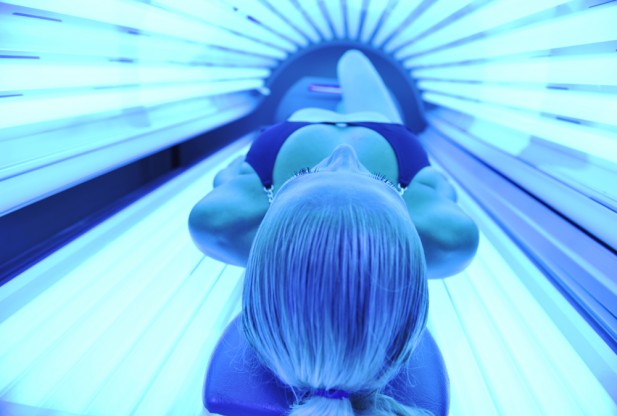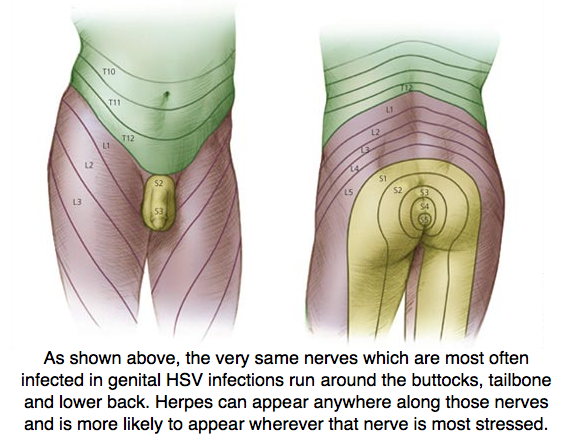A recent article in the UK’s Daily Mail includes an all-too-typical “herpes scare” shock headline:
“How you could catch HERPES from a sunbed: STI can thrive in tanning booths despite the heat, expert warns”

While a tanning bed might cause herpes to show up, it’s most likely that you carried it all along and didn’t know it.
No doubt that will bring many clicks and page views (which is all the media is really interested in) but it is rather sensationalist and ignores the bulk of the body of scientific research. It also ignores a whole bunch of logic.
We’re going to explain a bit about medical assumptions and the difference between possibility and probability.
Theoretically, it could happen. One could, in theory, acquire HSV and other herpesviruses from either a tanning bed or any of the many other surfaces and with which they come into contact daily. Theoretically.
Then again, theoretically you could hit a bullseye with a standard hunting rifle from 3 miles away, but a whole lot of variables have to fall into place before that will ever occur (nobody’s managed it yet.) The fact that things are possible doesn’t mean they occur with any regularity; only that they’re not impossible.
On to the article…
Unlike the headline states, you can’t “catch herpes” from a tanning bed or anywhere else. You can only acquire a herpesvirus, which you will undoubtedly do from another human being rather than a tanning bed. (spoiler alert: whether you know it or not, you already host a handful of them: all humans do.) What that tanning bed is highly likely to do is cause herpes, due to stressing your skin in combination with your existing HSV infection. Huge difference.
The doctor said HSV could survive, not that anyone would actually be likely to acquire it if it did. Survival is only step 1. In order to actually infect someone, the HSV must also be present in sufficient quantity; it also needs an entry point (microcut, tear, abrasion) in order to get under the skin to infect the nerve endings.
The article’s author and publisher didn’t help educate the public any, twisting this snippet and leading readers to believe that it’s entirely possible, if not a very realistic risk. They even state in their article that
“Genital herpes is highly contagious and spreads from one person to another via skin-to-skin contact”
…then they turn around and completely ignore that this is how people actually acquire HSV.
The tanning bed theory begins to unravel further once you understand the mechanics of herpesviruses, HSV and herpes (genital or otherwise.)
Naturally, one might prefer to believe (and profess) that their genital herpesvirus infection came from a tanning bed rather than sex. There’s a very strong emotional motive here. However, this scenario is actually terribly unlikely and it is far more likely that HSV infection already existed; that transmission and infection occurred how it almost always occurs – physical contact between two people – and that the herpes only appeared later on because of the act of tanning and the stress it put upon the skin.
Let’s take a closer look at the doctor’s statement:
“In my practice, I’ve seen acquired bacterial infections, warts, and herpes infections from tanning beds based on the timing of the infection and distribution of the infection.”
Wait. What? Someone walks into your office with herpes on their butt, having recently been tanning and magically, the latter is automatically not only the cause of the former, but responsible for the original transmission of the virus, too?
That isn’t science, people. That is guessing.
Dr. Davis has no idea from where that HSV actually came; only that herpes showed up on the tailbones of a few people shortly after tanning. She didn’t literally see the infections occur and she certainly never DNA tested the lesions and the tanning bed to confirm the source and the match. She merely saw a few new herpes patients who had recently been tanning. While she is making a plausible argument for the possible source of the HSV based upon a few logical assumptions, she hasn’t confirmed any of it. The actual source remains uncertain.
However, of some things we actually are quite certain:
- Solar radiation irritates the skin and is among the most common Herpes triggers
- An HSV infection anywhere in the S2/S3 nerves – the same ones that serve the genitals – and any adjacent infected nerves all have the potential for herpes anywhere along their length.
- Those nerves include the tailbone and butt area. It’s not at all uncommon for people to experience herpes outbreaks there.
- Tanning beds irritate the hell out of those same areas. They turn red from the amount of radiation they endure.
- Herpes is most likely to occur on skin which is stressed. Herpesviruses are the source of herpes, but stress is the cause.
- HSV infection requires an entry point into the skin. Generally, this is achieved by friction. There isn’t any friction laying in a tanning bed. In fact, it’s much more like a slip-n-slide
- Over 80% of humans tolerate HSV just fine without ever noticing it. It is only when the body is sufficiently stressed that herpes appears.
- Genital HSV infection isn’t remotely uncommon. The vast majority of humans host/carry HSV 1 or 2 and the body of research suggests that between the two types combined, over 1/3 of people of sexual maturity carry HSV of some type genitally* while less than 20% of us are actually aware of it.
It would stand to reason, then, that any pre-existing GH infection could easily cause herpes to appear on the tailbone or butt due to tanning radiation stress. In fact, herpes would be most likely to occur in these very areas where the potential exists (HSV-infected S2/S3 nerves); in the very area most stressed by spending time in a tanning bed.
It would also stand to reason that someone – even a Dermatologist (as opposed to a Virologist) – might naturally conclude that the infection came from the tanning bed itself without investigating any further. It’s much more likely, however, that these weren’t infections caused by the tanning beds; they were more likely to be existing Genital HSV infections in which the stressful act of tanning itself caused herpes to appear in the locations under greatest stress.
Acquiring HSV from a tanning bed isn’t entirely impossible, in theory. However, a person experiencing herpes on the tailbone, butt or lower back after tanning in a tanning bed due to an undiagnosed, unrecognized prior genital HSV infection is actually quite probable. Human beings – ourselves and most everyone we know – are actually the natural reservoir for HSV; not tanning beds. It just doesn’t show up in any of us until our bodies (and immune systems) are sufficiently stressed and tanning beds are more than capable of causing sufficient radiation stress. For most people it never shows up; for some, it does when the immune system is stressed and yes, even too much sun (real or fake) stresses the immune system.
As for the other message in the headline, detailed in the article…
“Bacteria that lies on a person’s skin can easily be transferred to the bed, when a person is lying down. The heat – not high enough to kill the infection – allows the bacteria to develop to become stronger and more able to survive. When a person sweats, it provides a breeding ground for bacteria or viruses.”
Viruses aren’t even alive to begin with.
Bacteria and viruses don’t breed – they have no reproductive organs – and while bacteria can flourish on their own, viruses can’t even replicate outside a host; all they can do is sit there until their viability clock runs out. There is no manner in which Herpesviruses “thrive” in a tanning bed or anywhere else, aside from within their natural host and when they’re active.
Ultimately, HSV is nothing more than a tiny bit of biological software (DNA) capable of taking over the function of a human nerve cell in order to replicate itself. Without that surrogate host cell, it can’t accomplish anything more than that old thumb drive sitting in your junk drawer could without being plugged into computer. Bacteria actually can thrive on surfaces, given the right conditions; herpesviruses cannot.
The only people who should be concerned about acquiring herpesviruses from tanning beds are those who have never make any physical contact of any sort with another human being. As for the rest of us, we would be ignoring the obvious to a spectacular degree.
It would be most helpful if medical professionals didn’t feed the media bears with assumptions and the media didn’t turn around and twist it into something bordering fallacy. Together, they provide a breeding ground for misinformation among the general public.
*Research has shown that around 16% host HSV-2; presumably genitally. It has also shown that at least that many, host HSV-1 genitally. More recently, various studies from numerous nations have shown that 50% or more of new genital herpes infections are actually HSV-1, rather than HSV-2.
Resources:
1. Bradley H, Markowitz LE, Gibson T, McQuillan GM (2014) Seroprevalence of herpes simplex virus types 1 and 2—United States, 1999–2010. J Infect Dis 209: 325–333 doi: 10.1093/infdis/jit45824136792[PubMed]
2. Roberts CM, Pfister JR, Spear SJ. Increasing proportion of herpes simplex virus type 1 as a cause of genital herpes infection in college students. Sexually Transmitted Diseases. 2003;30:797–800. doi: 10.1097/01.OLQ.0000092387.58746.C7. [PubMed] [Cross Ref]
3. Wald A. 2006. Genital HSV-1 infections. Sex. Transm. Infect. 82:189–190. 10.1136/sti.2006.019935[PMC free article] [PubMed] [Cross Ref]
4. Ribes J, Steele A, Seabolt J, et al. Six-years study of the incidence of herpes in genital and nongenital cultures in a Central Kentucky Medical Center patient population. J Clin Microbiol. 2001;39:3321–5.[PMC free article] [PubMed]
5. Scoular A, Norrie J, Gillespie G, Mir N, Carman W. Longitudinal study of genital infection by herpes simplex virus type 1 in Western Scotland over 15 years. Br Med J. 2002;324(7350):1366–13667. doi: 10.1136/bmj.324.7350.1366. [PMC free article] [PubMed] [Cross Ref]









